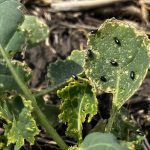Yield losses of more than 50 per cent can occur from bluegrass competition in winter wheat. As well, because bluegrass species often head at the same time as winter wheat, they could intercept and reduce the amount of fusarium head blight fungicide that actually reaches the grain head (Figure 1 at top).
There are several species of bluegrass found in Ontario. Annual, roughstalk and Canada bluegrass are the most common species in field crops. These competitive grassy weeds will emerge in the fall or early spring. Plants smaller than 10 centimetres (4 inches) in height are more easily controlled by herbicides. Based on preliminary Ontario data in winter wheat, April herbicide applications made to bluegrass are more effective than May applications.
Testing herbicide effectiveness

An on-farm research trial evaluated five different herbicides, three of which are currently available in Ontario. The field site contained primarily roughstalk bluegrass. Herbicides were applied when bluegrass was 5 to 7.5 cm (2 to 4 in.) tall (Figure 2 above) and the winter wheat crop was just at stem elongation. By contrast, the rest of the field was sprayed one month later when bluegrass was between 20 and 30 cm (8 and 12 in.) tall.
Read Also

Agronomists share tips for evaluating new crop products and tech: Pt. 3
With new products, new production practices and new technology converging on the agriculture industry at a frenetic pace in recent…
Key learnings:

- Axial, Simplicity GoDRI and Varro provided excellent control of roughstalk bluegrass that was less than 10 cm (4 in.) tall at application. (Figure 3, Figure 4 above)
- Delaying herbicide applications into May, when bluegrass was greater than 20 cm (8 in.) tall, reduced control but did keep bluegrass from heading above the wheat canopy (as of June). However, there was plenty of bluegrass under the wheat canopy that was beginning to flower (Figure 5 at bottom). This will likely result in seed dispersal back into the field.
- Varro herbicide has label restrictions against its use when temperatures are below 3 C and/or winter wheat has reached the first node stage of growth. Both those restrictions were violated in this experiment. Significant yellowing and slight stunting occurred as a result. However, plants fully recovered within 14 days of application.

Have a question you want answered? Hashtag #PestPatrol on Twitter to @cowbrough or email Mike at [email protected].















